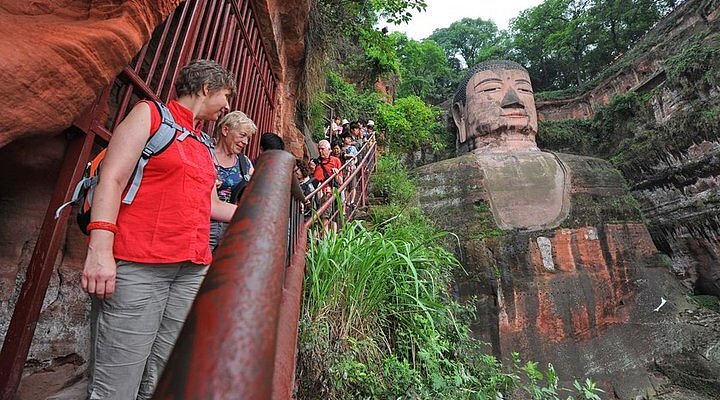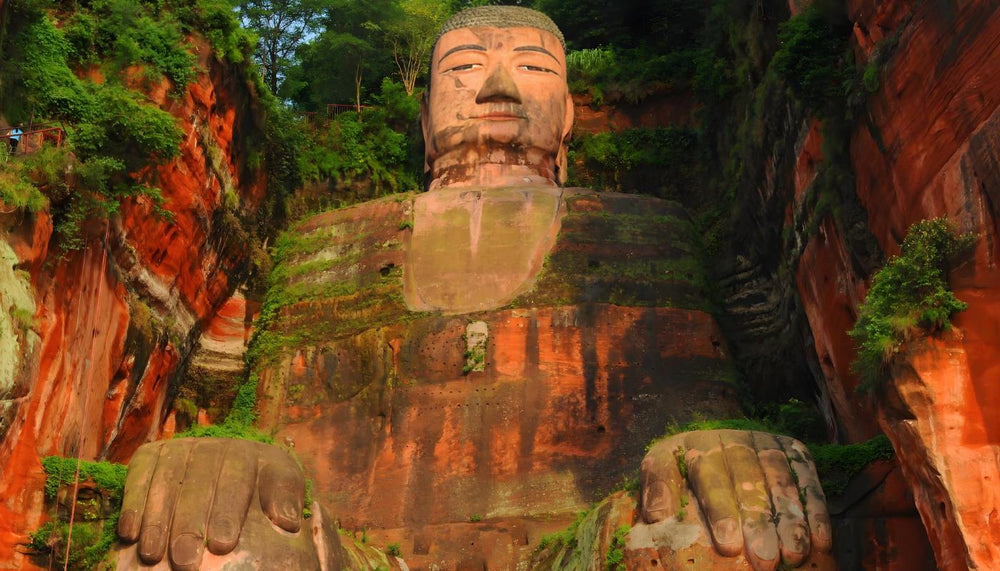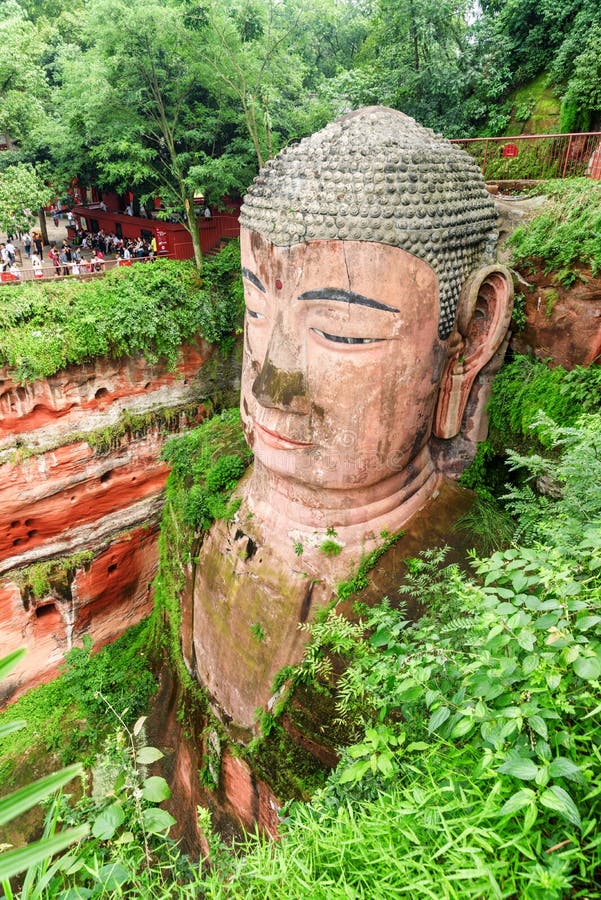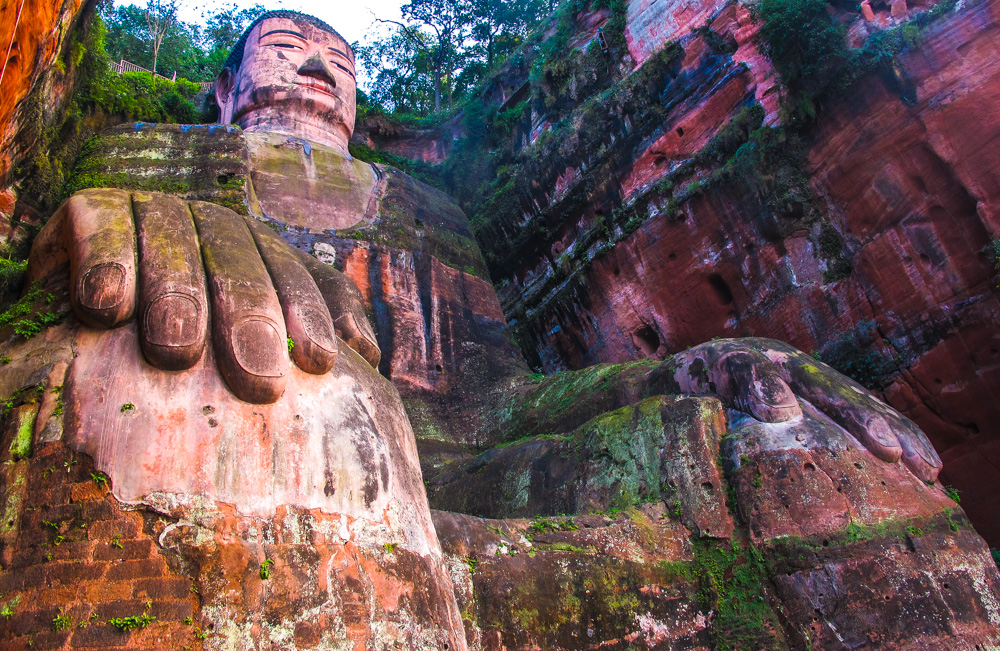Experience Tranquility at Leshan: Home of the Magnificent Giant Buddha

An Essential Guide to Visiting Leshan Buddhist Sculptures
Nestled in the lush landscapes of southwestern China, the Leshan Buddhist Sculptures stand as a monumental testament to the artistry and spirituality of ancient Chinese civilization. This UNESCO World Heritage site, home to the awe-inspiring Leshan Giant Buddha, invites travelers to embark on a journey through time, where the story of Buddhism is carved into the very rock of the earth. Standing at an impressive 71 meters tall, the Giant Buddha is not just the largest stone Buddha in the world; it is also a symbol of peace and compassion that has drawn pilgrims and tourists alike for centuries.
As you approach the site, the air thickens with a sense of reverence, and the natural beauty of the surrounding mountains and rivers enhances the spiritual atmosphere. The intricate details of the sculptures, which date back to the 8th century, reveal the remarkable craftsmanship of the era and the deep cultural significance of Buddhism in China. Whether you choose to explore the winding paths on foot or take a serene boat ride along the river, each perspective offers a unique view of these magnificent works of art.
In this guide, we will delve into the rich history, essential tips for visiting, and the best ways to experience the Leshan Buddhist Sculptures, ensuring your journey is as enriching and unforgettable as the sculptures themselves. Prepare to be inspired as you step into a world where art, faith, and nature converge in perfect harmony.
In This Guide
- An Essential Guide to Visiting Leshan Buddhist Sculptures
- The Rich History and Legends of Leshan Buddhist Sculptures
- Main Highlights: What You Absolutely Can’t Miss
- Planning Your Visit: A Practical Guide
- Tickets: Prices, Booking, and Tips
- How to Get There: A Complete Transportation Guide
- Local Cuisine and Accommodation Nearby
- Frequently Asked Questions
- Final Thoughts on Your Trip
The Rich History and Legends of Leshan Buddhist Sculptures
The Leshan Buddhist Sculptures, nestled in the breathtaking landscape of Sichuan province, are not just remarkable art pieces; they are the embodiment of centuries of devotion, craftsmanship, and spiritual significance. The most iconic of these sculptures is the Leshan Giant Buddha, a monumental statue carved during the Tang Dynasty in the 8th century AD. Standing at an impressive 71 meters, this colossal figure has earned its place as the tallest stone Buddha in the world, overshadowing even the famed Buddhas of Bamyan in Afghanistan.
The history of the Leshan Giant Buddha is rooted in a narrative of aspiration and ambition. The project began around 713 AD, commissioned by a monk named Haitong. He envisioned the Buddha as a protector for the sailors navigating the treacherous waters of the confluence of the Min, Dadu, and Qingyi rivers. Haitong believed that by carving a massive Buddha into the cliffside, the divine presence would calm the rivers and ensure safer passage. His vision took decades to realize, and despite the immense challenges, the craftsmanship reflected in the intricate details of the statue is a testament to the skill and dedication of the artisans involved.
As the years rolled on, the site evolved into a flourishing center for Buddhist learning and pilgrimage. The presence of the Giant Buddha attracted monks, scholars, and devotees, establishing a rich spiritual atmosphere that reverberated throughout the region. The sculptures, including the nearby lesser-known carvings of bodhisattvas and other religious figures, contributed to Leshan’s reputation as a significant Buddhist site.
The sculptures are not merely artistic achievements; they are steeped in legend. One popular tale tells of the spirit of a local river deity who was angered by the construction of the Buddha. To appease the deity, the sculptors are said to have offered their own sacrifices, leading to the Buddha being imbued with protective powers. This legend continues to draw visitors who seek blessings and solace from the Giant Buddha’s benevolent gaze.
In 1996, the significance of Leshan’s Buddhist sculptures was recognized by UNESCO, which designated the site as a World Heritage Site in conjunction with Mount Emei. This designation highlights the cultural and historical importance of the area, which remains a pivotal pilgrimage destination for Buddhists from around the globe.
Today, as travelers tread the paths leading to the Giant Buddha, they walk in the footsteps of countless pilgrims who have come to witness this awe-inspiring fusion of art, faith, and nature. The Leshan Buddhist Sculptures are not just relics of the past; they are living symbols of a rich history that continues to inspire reverence and wonder in all who visit.

Leshan Buddhist Sculptures.
Main Highlights: What You Absolutely Can’t Miss
When visiting the Leshan Buddhist Sculptures, particularly the iconic Leshan Giant Buddha, there are several highlights that you simply cannot miss. This UNESCO World Heritage Site, carved into the cliffside in the 8th century, is not only an architectural marvel but also a serene sanctuary for those seeking spiritual reflection. Here’s what to prioritize during your visit:
The Leshan Giant Buddha
-
Height and Design: Standing at an impressive 71 meters (233 feet), the Leshan Giant Buddha is the tallest stone Buddha statue in the world. Its sheer size and intricate details, including the flowing robes and serene facial expression, make it a breathtaking sight. Don’t miss the opportunity to capture stunning photographs from various vantage points.
-
Viewing Points: To fully appreciate the scale of the Buddha, explore different viewing platforms around the site. The most popular spots include the viewing platform directly across the river, which offers an unobstructed view of the Buddha’s grandeur, especially during sunset.
Scenic Walkways
-
Path to the Buddha: The walk leading to the Buddha is just as captivating as the statue itself. As you ascend the stone steps, take time to admire the beautiful natural surroundings, including lush greenery and ancient trees. The pathways are lined with smaller statues and carvings that tell the story of Buddhist teachings, enriching your experience.
-
The Twelve Disciples: Along the path, you’ll encounter a series of smaller statues representing the twelve disciples of Buddha. These sculptures provide insight into Buddhist lore and are perfect for a moment of reflection as you continue your journey.
Boat Tour
- River Cruise: For a unique perspective, consider taking a boat tour on the Min River. This serene ride allows you to see the Giant Buddha from below, giving you an appreciation for its scale and the skill it took to carve such a monumental figure from the rocky hillside. The boat ride is particularly magical in the early morning or late afternoon when the light enhances the statue’s features.
Mount Emei (Emei Shan)
- Nearby Exploration: Just a short distance from Leshan lies Mount Emei, another UNESCO World Heritage Site. This sacred mountain features stunning temples, scenic hiking trails, and beautiful vistas. If time permits, a visit to Mount Emei complements your trip to Leshan and offers a deeper understanding of Buddhist culture.
Cultural Experience
-
Local Cuisine: Don’t miss the chance to savor local Sichuan cuisine in the surrounding area. Try the famous spicy hot pot or sample vegetarian dishes inspired by Buddhist principles, made using fresh, local ingredients.
-
Souvenir Shopping: Before you leave, explore the local shops for Buddhist artifacts, handicrafts, and memorabilia that capture the essence of your visit. These items make for meaningful souvenirs or gifts for loved ones.
Practical Tips
-
Best Time to Visit: Early morning or late afternoon are the best times to visit to avoid crowds and enjoy cooler temperatures. The softer sunlight during these hours enhances the beauty of the sculptures.
-
Accessibility: While the paths to the Buddha can be steep, they are well-maintained. Ensure you wear comfortable shoes and stay hydrated, especially during warmer months.
By prioritizing these highlights during your visit to the Leshan Buddhist Sculptures, you’ll not only witness one of the greatest artistic achievements of the ancient world but also immerse yourself in the rich cultural tapestry of Buddhism in China.

Leshan Buddhist Sculptures.
Planning Your Visit: A Practical Guide
Planning Your Visit: A Practical Guide to Leshan Buddhist Sculptures
Visiting the Leshan Buddhist Sculptures, particularly the iconic Leshan Giant Buddha, is a journey through time, culture, and spirituality. This comprehensive guide will help you navigate your trip, ensuring a fulfilling experience at one of China’s most remarkable UNESCO World Heritage Sites.
Getting There
Location
The Giant Buddha is located in Leshan City, approximately 140 kilometers (about 87 miles) from Chengdu, the capital of Sichuan Province. This proximity makes Leshan an accessible day trip or overnight excursion.
Transportation Options
-
By Train: High-speed trains run frequently from Chengdu East Railway Station to Leshan Railway Station, with a journey time of about one hour. Make sure to check the train schedule ahead of time. The station is roughly 13 kilometers from the Buddha, so consider taking a taxi or local bus once you arrive.
-
By Bus: If you prefer a more budget-friendly option, buses depart regularly from Chengdu’s Xinnanmen Bus Station to Leshan. The ride takes about 2.5 hours, so plan accordingly.
-
By Car: Renting a car or hiring a private driver is a convenient option, especially for families or groups. The drive takes approximately two hours and allows for a more personalized travel experience.
Best Time to Visit
The best time to visit Leshan is during the spring (March to May) and autumn (September to November) months when the weather is pleasant, and the scenery is breathtaking. Summer can be hot and crowded, while winter experiences cooler temperatures, though the Buddha looks magnificent against a crisp sky.
Entry Fee and Opening Hours
-
Ticket Price: Admission to the scenic area, which includes the Giant Buddha, typically costs around CNY 90 (approximately USD 14). Additional fees may apply if you wish to take a boat tour.
-
Opening Hours: The site is generally open from 7:30 AM to 6:00 PM, but hours may vary seasonally. It’s advisable to arrive early to avoid the crowds, especially during peak tourist seasons.
Exploring the Site
On Foot:
The most popular way to experience the Giant Buddha is by walking through the scenic area. This route involves a gradual ascent that offers panoramic views of the surrounding landscape. Be prepared for some physical exertion, as the trek may take several hours, depending on your pace.
By Boat:
An alternative way to view the Buddha is from the water. Boat tours generally last about 30 minutes and provide a unique perspective of the sculpture, allowing you to appreciate its grandeur from below.
Guided Tours:
Consider joining a guided tour for an enriching experience. Local guides often provide insights into the history, art, and significance of the sculptures, enhancing your understanding of this cultural treasure.
What to Bring
- Comfortable Footwear: As you’ll be walking quite a bit, wear sturdy shoes.
- Water and Snacks: Stay hydrated and energized, especially if you’re visiting during warmer months.
- Camera: Capture the breathtaking views and intricate details of the sculptures.
- Sunscreen and Hat: Protect yourself from the sun, particularly during summer.
Nearby Attractions
While in Leshan, consider extending your visit to include other nearby attractions:
-
Mount Emei: Just a 45-minute drive away, this sacred Buddhist mountain is home to stunning landscapes and ancient temples. It’s a great way to deepen your exploration of Buddhist culture.
-
Leshan Giant Buddha Museum: Learn more about the history of the Giant Buddha and the art of stone carving through exhibits and artifacts.
-
Local Cuisine: Don’t miss the chance to savor Sichuan’s famous spicy dishes at local restaurants. Look for specialties like hot pot and mapo tofu.
Final Tips
- Plan Your Visit: Check the weather forecast and train schedules ahead of time.
- Respect Local Customs: As you are visiting a religious site, dress modestly and be mindful of the local culture.
- Stay Connected: Download a translation app or carry a phrasebook to help communicate with locals.
By following this guide, you’ll be well-prepared to explore the awe-inspiring Leshan Buddhist Sculptures and create unforgettable memories in this remarkable part of China. Safe travels!

Leshan Buddhist Sculptures.
Tickets: Prices, Booking, and Tips
Visiting the Leshan Giant Buddha, a UNESCO World Heritage Site, is an unforgettable experience. To make the most of your trip, understanding the ticketing process, prices, and some handy tips can enhance your visit.
Ticket Prices
As of 2023, the entrance fee for the Leshan Giant Buddha scenic area is approximately 80 CNY (around $12 USD). This ticket grants you access to the main viewing areas, including the paths leading to the Buddha and the surrounding scenic spots.
For those looking to explore more, consider the combined ticket that includes both the Leshan Giant Buddha and Mount Emei, priced at about 150 CNY (around $23 USD). This option is ideal if you plan to visit both iconic sites in one trip.
Booking Tickets
Tickets can be purchased in advance online or directly at the entrance. If you’re traveling during peak seasons, such as Chinese holidays, it’s advisable to book your tickets ahead of time to avoid long queues. Many travelers recommend using official ticketing platforms or reputable travel agencies to ensure a smooth booking process.
Tips for Your Visit
-
Best Time to Visit: The ideal time to visit the Leshan Giant Buddha is during the spring (April to June) and autumn (September to November) when the weather is mild and the crowds are smaller. Early mornings are also less crowded, allowing for a more serene experience.
-
Plan for Crowds: The site can get quite busy, especially on weekends and holidays. Aim to visit during weekdays if possible, and arrive early to enjoy the site before the crowds arrive.
-
Explore on Foot or by Boat: You can choose to see the Buddha up close by walking down the paths or from a distance on a scenic boat ride. Each option offers a unique perspective, so consider doing both if time permits.
-
Wear Comfortable Shoes: If you decide to explore on foot, make sure to wear comfortable shoes, as the paths can be steep and uneven.
-
Stay Hydrated: It’s essential to bring water, especially during the summer months, as you’ll be doing a fair bit of walking.
-
Combine with Other Attractions: If time allows, consider combining your visit to the Leshan Giant Buddha with a trip to Mount Emei, another UNESCO site nearby, for a full day of exploration.
By keeping these tips in mind and planning ahead, your visit to the Leshan Giant Buddha can be both enjoyable and enriching. Happy travels!
How to Get There: A Complete Transportation Guide
Reaching the Leshan Buddhist Sculptures, particularly the iconic Leshan Giant Buddha, is an essential part of your travel experience in Sichuan, China. This UNESCO World Heritage site is conveniently located near Chengdu, making it accessible for international travelers. Below is a comprehensive guide on how to get there, whether you prefer the speed of trains, the ease of driving, or the affordability of buses.
From Chengdu to Leshan
By High-Speed Train
One of the most efficient and comfortable ways to reach Leshan is by high-speed train. Here’s how you can do it:
- Departure Station: Chengdu East Railway Station is the primary terminal for high-speed trains to Leshan, with some services stopping at Chengdu Shuangliu International Airport.
- Frequency: Approximately 30 trains depart daily, with the earliest around 6:30 AM.
- Journey Duration: The ride takes about 1 hour.
- Arrival Station: Leshan Railway Station (乐山火车站) is roughly 13 km from the Giant Buddha, which takes about 30 minutes by taxi or local bus (Bus 605 or Bus 3).
Tip: For a faster journey, book direct trains that do not stop at the airport.
By Bus
If you prefer a more budget-friendly option, taking a bus can be a good choice:
- Departure Point: Buses leave from Chengdu’s Xinnanmen Bus Station.
- Duration: The journey takes about 2.5 hours.
- Cost: Bus tickets are generally cheaper than train fares.
Note: While this option is more economical, it is less time-efficient than the high-speed train.
By Car
For those seeking a more personalized travel experience, driving from Chengdu offers the flexibility to explore the scenic routes:
- Duration: The drive takes about 2 hours, depending on traffic.
- Recommendation: This is especially recommended for families or travelers who prefer to avoid crowded public transport. You can enjoy the landscape at your own pace.
From Emeishan to Leshan
If you’re visiting Mount Emei (Emeishan) before heading to the Giant Buddha, you have several options:
By High-Speed Train
- Departure Station: Emeishan High-Speed Railway Station (峨眉山高铁站), located about 2km from the tourist center of Mount Emei.
- Frequency: Trains to Leshan are available throughout the day (usually three trains).
- Duration: The train ride takes approximately 15-20 minutes.
By Taxi or Tourist Bus
- Duration: A taxi ride from Mount Emei to Leshan takes about 45 minutes.
- Cost: This option is convenient, especially if traveling in a group.
Final Tips for Your Visit
- Buying Tickets: Ensure to purchase your tickets in advance, especially during peak travel seasons.
- Visit Options: You can explore the Leshan Giant Buddha by walking the scenic paths or taking a boat ride along the river for a unique perspective.
- Best Time: For a more pleasant experience, consider visiting early in the morning or late afternoon to avoid crowds.
With this guide, you’re all set to embark on an unforgettable journey to the Leshan Buddhist Sculptures. Enjoy your adventure!

Leshan Buddhist Sculptures.
Local Cuisine and Accommodation Nearby
When visiting the awe-inspiring Leshan Giant Buddha, indulging in local cuisine and finding comfortable accommodation can greatly enhance your travel experience. Here’s a guide to some delightful dining options and cozy places to stay nearby.
Local Cuisine
Sichuan cuisine is renowned for its bold flavors and spicy dishes, and Leshan is no exception. Here are a few must-try local dishes and recommended eateries:
-
Sichuan Hot Pot: A culinary adventure not to be missed! Dive into a bubbling pot of spicy broth filled with meats and vegetables. Haidilao Hot Pot is a popular chain that guarantees a lively dining experience with excellent service.
-
Leshan Grilled Fish: Freshwater fish from the nearby rivers is grilled to perfection and seasoned with a medley of spices. Head to Leshan Fish Restaurant for a local favorite that highlights the region’s aquatic bounty.
-
Mapo Tofu: This iconic dish features tofu in a spicy sauce made with Sichuan peppercorns. You can savor a great rendition at Leshan Old Town Tofu House, where traditional recipes meet a charming atmosphere.
-
Dan Dan Noodles: A deliciously spicy noodle dish, often garnished with ground pork and scallions, is perfect for a quick meal. Leshan Noodle Shop offers a fantastic version that will leave you craving more.
Accommodation Nearby
After a day exploring the majestic sculptures, retreat to one of these comfortable accommodations:
-
Leshan Grand Hotel: Just a short drive from the Giant Buddha, this hotel offers modern amenities, spacious rooms, and an on-site restaurant serving both local and international cuisine. It’s perfect for travelers seeking comfort and convenience.
-
Hotel Leshan: Located in the heart of the city, this hotel provides easy access to public transportation and local attractions. The rooms are well-appointed, and the staff is friendly, ensuring a pleasant stay.
-
Emeishan Qianfo Hotel: If you prefer a more serene atmosphere, consider staying at this hotel located near Mount Emei, which is only a short distance from Leshan. The hotel features beautiful mountain views and offers a peaceful retreat after a day of sightseeing.
-
Leshan Youth Hostel: For budget-conscious travelers, this hostel provides a friendly environment and a chance to meet fellow adventurers. It’s conveniently located and offers basic yet comfortable accommodations, perfect for a laid-back stay.
As you plan your visit to the Leshan Giant Buddha, don’t forget to savor the exquisite flavors of Sichuan cuisine and unwind in one of these welcoming accommodations. Your journey will be enriched by the local tastes and cozy stays that complement the spiritual magnificence of the sculptures. Enjoy your trip!

Leshan Buddhist Sculptures.
Frequently Asked Questions
Frequently Asked Questions about Leshan Buddhist Sculptures
1. What is the Leshan Giant Buddha, and why is it significant?
The Leshan Giant Buddha is a monumental statue carved out of a cliff face in the 8th century, standing at an impressive 71 meters (233 feet) tall. It is the tallest stone Buddha in the world and is a UNESCO World Heritage Site, recognized for its historical and artistic significance in Buddhism.
2. How do I get to the Leshan Giant Buddha from Chengdu?
You can reach the Leshan Giant Buddha from Chengdu by several means:
– High-Speed Train: The most efficient option, taking about 1 hour from Chengdu East Railway Station to Leshan Railway Station.
– Car: Driving takes approximately 2 hours, offering a comfortable journey.
– Bus: Frequent buses depart from Chengdu Xinnanmen Bus Station, but the journey takes around 2.5 hours.
3. What are the best times to visit the Leshan Giant Buddha?
The best times to visit are during spring (March to May) and autumn (September to November) when the weather is mild and pleasant. Avoid public holidays and weekends if you prefer fewer crowds.
4. Are there any entrance fees?
Yes, there is an entrance fee to visit the Leshan Giant Buddha scenic area. The ticket prices may vary, so it’s advisable to check the official site or inquire at the entrance for the most current rates.
5. Can I visit the Leshan Giant Buddha and Mount Emei in one trip?
Absolutely! Many travelers combine visits to both sites. They are located close to each other, and organized tours are available that cover both the Giant Buddha and Mount Emei, allowing you to experience two UNESCO World Heritage Sites in one day.
6. What should I wear and bring for my visit?
Wear comfortable shoes for walking, as you’ll be navigating a series of paths and steps. It’s also wise to bring a hat, sunscreen, and water, especially during the warmer months, to stay hydrated and protected from the sun.
7. Can I take photos at the Leshan Giant Buddha?
Yes, photography is allowed in most areas of the scenic site. However, be respectful of the religious significance of the site and avoid taking photos in restricted areas or of worshippers.
8. What are the options for guided tours?
Many tour companies offer guided tours to the Leshan Giant Buddha, which often include transportation, a knowledgeable guide, and sometimes additional stops in the Chengdu area. This can enhance your experience and provide deeper insights into the history and culture of the site.
Final Thoughts on Your Trip
As you conclude your journey to the magnificent Leshan Giant Buddha, take a moment to reflect on the awe-inspiring craftsmanship and the spiritual ambiance that envelops this UNESCO World Heritage Site. Standing majestically at 71 meters, this colossal sculpture is more than just a feast for the eyes; it embodies centuries of cultural heritage and devotion.
Whether you wandered the scenic paths that lead you to its feet or glided across the waters for a different perspective, your experience at Leshan is bound to resonate long after you leave. The gentle whispers of history that linger in the air, alongside the serene presence of the Buddha, invite you to pause and contemplate your own journey—both in travel and in life.
As you prepare to depart, consider carrying these lessons with you: the beauty of patience, the significance of mindfulness, and the importance of connecting with the world around you. Leshan is not just a destination; it’s a reminder of the timeless stories etched in stone, waiting to inspire future generations.
So, whether you’re heading back to bustling Chengdu or off to explore more of China’s wonders, know that the spirit of Leshan will remain with you, encouraging a deeper understanding of culture, art, and the profound journey we all share. Safe travels, and may your adventures continue to enrich your life!